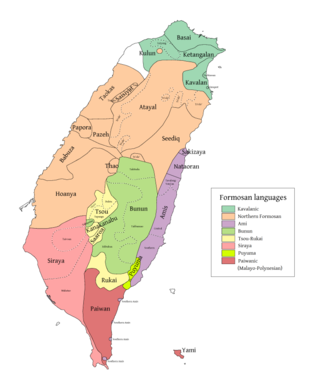This article should specify the language of its non-English content, using {{lang}}, {{transliteration}} for transliterated languages, and {{IPA}} for phonetic transcriptions, with an appropriate ISO 639 code. Wikipedia's multilingual support templates may also be used. (March 2021) |
| Kavalan | |
|---|---|
| kbaran, kebalan (Kavalan)[1] | |
| Pronunciation | [kɨβaɾán] |
| Native to | Taiwan |
| Ethnicity | Kavalan |
Native speakers | 70 (2015)[2] |
| Language codes | |
| ISO 639-3 | ckv |
| Glottolog | kava1241 |
| ELP | Kavalan |
 (dark green, north) The Kavalanic languages: Basai, Ketagalan, and Kavalan | |
Kavalan (also known as Kvalan, Kebalan or Kbalan) was formerly spoken in the Northeast coast area of Taiwan by the Kavalan people (噶瑪蘭). It is an East Formosan language of the Austronesian family.
Kavalan is no longer spoken in its original area. As of 1930, it was used only as a home language. As of 1987, it was still spoken in Atayal territories. In 2000, this language was still reported to be spoken by 24 speakers but considered moribund.
In 2017, a study using the EDGE metric from species conservation found that Kavalan, although critically endangered, was among the most lexically distinct of Austronesian languages.[3]
- ^ Yuanzhuminzu weiyuanhui, zuyu shuwei zhongxin 原住民族委員會, 族語數位中心. "Yuèdú shūxiě piān – Gámǎlányǔ dì 6 kè – zúyǔ E lèyuán" 閱讀書寫篇 – 噶瑪蘭語 第6課 – 族語E樂園. Yuedu shuxie pian – zuyu E leyuan (in Chinese).
- ^ Kavalan at Ethnologue (24th ed., 2021)

- ^ Perrault, Nicolas; Farrell, Maxwell J.; Davies, T. Jonathan (2017). "Tongues on the EDGE: Language Preservation Priorities Based on Threat and Lexical Distinctiveness". Royal Society Open Science. 4 (12): 171218. Bibcode:2017RSOS....471218P. doi:10.1098/rsos.171218. PMC 5750020. PMID 29308253. S2CID 23970007.